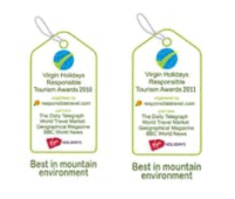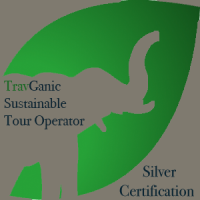Top reasons to go trekking in Nepal during the off season
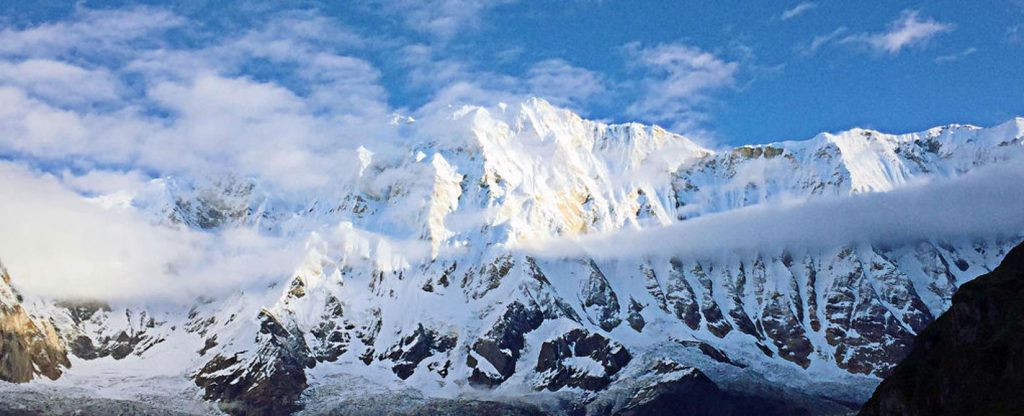
It is widely established that the Nepal Himalaya’s peak times are October–November and March, and April. However, trekking during the less busy season has its advantages. There are two recognized off-peak seasons for trekking in Nepal – the winter and the monsoon. The benefits of going on a trek during the low season. The trails won’t be busy with other trekkers, and you won’t have queues to shower at the lodge. Sometimes you could be the only trekker in the hostel. Trekking during the off-season is my favourite period. Trekking during December, January, and February. The colder winter months mean the clouds rise later to cover the beautiful mountains that Nepal is famous for. Winter is often the clearest time of year due to the colder temperatures. Sometimes the hills stay visible for days on end. Won’t it be cold, and what about snowfall? It can be crisp to cold in the mornings, depending on how high you are. However, you will warm up as soon as you start your day’s hike; you could even be sweating while walking. Have warm layers of clothing in your daypack to layer up when you stop for lunch or at the end of the day. In the evenings, the lodge owners light up the heater in the dining, which should keep you nice and toasty. We receive precipitation a few days every month except during the monsoon, when it rains more frequently. You might get snowfall in the higher altitudes, usually above 3000 meters, but it melts away in a couple of days. You might think to be at the base of the world’s highest mountains; snow could cover the trails and make it risky to trek. Remember that Nepal’s latitude is similar to Cairo and Miami, which is not too far north of the equator, making it much less cold than Europe or North America. You would still have to be careful when you come across frozen streams and might encounter icy parts on the trail early in the mornings or where the sun doesn’t shine much. Believe it or not, Nepal receives more snowfall during spring than winter. Therefore, an added benefit of winter trekking is that you will burn more calories as your body keeps you warm. Trekking in Nepal during May and June It can be pretty hot in the lower elevations of your trek, but it starts being more refreshing and pleasant as you gain altitude. If you are going to a height above 4500 meters, you will see many flowers in bloom, and it is green everywhere. You will also see beautifully colourful moths of all sizes during these months. Another benefit of this trekking during May and June will be burning calories; as it is warmer, you will sweat more, which means detoxification. Trekking will lack other trekkers and no queues to go through narrow trails or cross bridges during the end of the season’s most significant benefit. You will feel like you have the hills entirely to yourselves at times. You will walk through peaceful villages and their farmland, take your time to stop to observe the villagers go about their daily lives, and photograph them. Don’t be surprised if you are the only one at some lodges. The lodge owners won’t be as busy as during the peak season; some like to mingle with you. You could learn about their lifestyle, ask them how tourism has helped them, etc. This could be the beginning of a new friendship. If you are travelling with a small group, you can have leisurely meals, chat, and discuss other trekkers without being self-conscious. Weather Patterns The weather is the most significant concern for those planning to trek during the off-season. The weather in the mountains is unpredictable – more so these days with the effects of global warming. You can be fortunate to see glimpses of the majestic peaks even during May and June. There have been some years when severe weather has affected Lukla or Jomsom’s flights for up to a week during the best times of October and November. I led two treks in July 2017 – one to Helambu and one to Annapurna Base Camp. The Helambu trek was great because we barely saw a total of 10 other trekkers for the entire seven days we were there. We often had lodges to ourselves. The lodge owners were grateful for the income we brought to them during the off-peak season. Unfortunately, we didn’t get to see any snow-clad Peaks. It rained on us for some part of the days – mainly during the afternoons. It rained on us a few days during the monsoon trek to Annapurna Base camp. However, when we were at Machapuchare and Annapurna base camp, the clouds opened up, and we were rewarded with stunning views of the mountains. Unlike in Helambu, we were surprised by how busy the trek to Annapurna Base camp was. As mentioned before, the weather in the mountains is unpredictable. Hundreds of flowers also greeted us, and we enjoyed eating wild herbs and vegetables that only grow during the monsoon season. The scenery was lush green on both these treks. While trekking during the summer months, you will see farmers working their land or crops growing on their farmland and wake up to the song of birds in the morning. Can’t trek during the peak season? Don’t despair if you can take time off to trek during the peak season. You can avoid the crowds and have the trail, hills, and lodges to yourself. Consider visiting Nepal to do a hike during the off-season months of December, January, May, and June or even during the monsoon months of July and August. Mother Nature is always beautiful; we must find positive aspects of what lies in front of us. As the saying goes – “If life gives you lemons – make lemonade.” Happy trekking! Do I get a discount when I go trekking during the offseason? The answer is no. You don’t get discounts when you go trekking during the offseason
Everest base camp trek with the highest golf tee offs by a foreigner
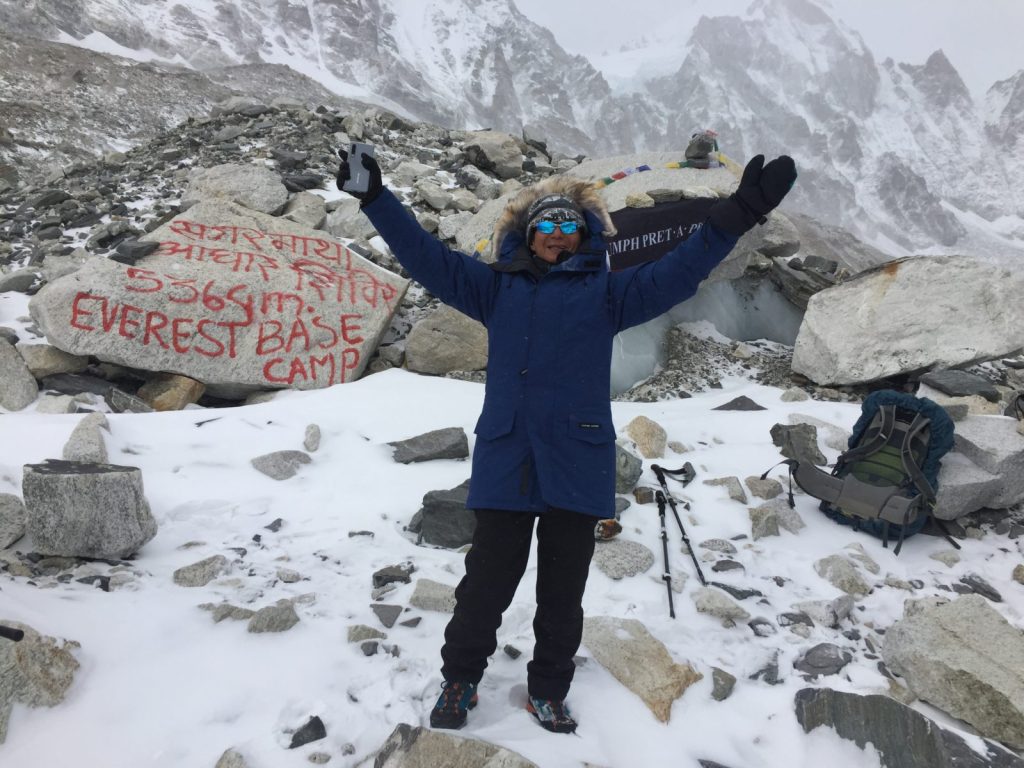
Everest base camp trek with the highest golf tee-offs by a foreigner. I took Harry Tan, a 71-year-old trekker from Singapore, to Everest base camp on a trek (not a climb to the top). I devised the idea to make this a trek to Everest base camp with a twist. This idea came to me on the morning of 7th December as he was flying here to make him tee off from 3 places above the altitude of 5000 meters. I had known him since 2015 when he came to golf with members of the Seletar golf club before the massive earthquake on 25th April 2015. He did a short trek in 2016 and was here in March this year with other club members. He is a keen golfer and part-time Physical Education teacher at Nanyang Technical University. 8th to 13th December 2019. We did this trek on our regular itinerary by flying to Lukla, trek to Namche, a side acclimatization trek to Amadablam base camp, etcetera. We hiked to Dingboche according to our plan. It started snowing lightly on the 6th morning from around 6.30 am. Upon reaching Dingboche, we stopped in a shop so Harry could buy warmer gloves, as the two pairs he brought from Singapore were not doing the ‘job.’ So instead, he ended up buying a pair of feather mittens. We just hung around the lodge, eating/drinking hot food and beverages. It continued to snow lightly for around 22 to 24 hours with occasional short breaks. 14th December 2019 We started our hike on a partially cloudy/foggy morning in the snow between 30 and 50 centimetres in depth. Despite December being the slow season, 70 to 100 other trekkers were on the trail. We reached our destination Lobuche 4940 meters, at 4 pm with the boots all damp. 15th December 2019 This was a massive day as Harry would be teeing off from 2 above 5000 meters. It began snowing lightly from 7 am, with the wind swirling up the valley behind us, blowing snow/sand. We hiked for about 90 to 100 minutes before reaching the flattish ground on Lobuche pass to Gorakshep 5180 meters. We stopped to bring out our 3 Wood driver, rubber tee, and an ecobioball manufactured by Albusgolf. These balls were imported from Europe 3 years ago for my project. It was a complete whiteout when Harry did the first-ever 5000-meter tee-off by a foreigner, a fellow Singaporean; Mark arrived just in time to witness this feat. We became friends six days ago in Namche Bazaar and crossed paths regularly on the trail. We continued on the lateral moraine towards Gorakshep. We had a quick lunch and left for the Everest base camp. We were the last to reach EBC and planned to avoid unnecessary attention from other trekkers. However, the other trekkers talked about a Singaporean with a golf club and wondered what he would do with it. We reached EBC trudging through snowy/icy conditions with strong wind gusts. Harry had to practice his swings with five layers of jackets in cold and windy conditions, not an easy feat for someone from sea level and a warm tropical country. Nevertheless, he managed to get an excellent swing. We headed back to Gorakshep for the night. Unfortunately, we learned that the overnight temperature was between -18 to -20 degrees Celcius. 16th December 2019 This was another significant day as Harry was going to tee off from Gorakshep at 5180 meters, and as it was a very clear day, once more from Lobuche pass. So Harry teed off from Gorakshep and Lobuche pass (a world difference between a foggy morning and a bright sunny day). We stopped at Pheriche and not Pangboche as planned due to the conditions of the trail. We had been walking on snowy/icy trails for the fourth day. 17th December 2019. We had planned to reach Namche Bazaar on this day. Instead, we had a gloriously bright morning with 360-degree views. Shomare the first settlement after leaving Pheriche, took us nearly two hours in snowy and icy conditions. On regular days it is only a 45-minute hike. There are patches of very icy trails where communal taps are left running to avoid pipes bursting below freezing temperatures. Before reaching Pangboche (standard time 90 minutes), which had taken us more than 3 hours, I gave Harry the option of flying down to Lukla by helicopter, bypassing these treacherous conditions and avoiding getting injured. Harry was happy to fly by chopper as it would also be his first experience. First, however, we had to wait a few minutes for the helicopter to bring cargo on a sling to arrive, leave the load, and get us to Lukla. We arrived in Lukla after a short 7 minutes but a thrilling flight by helicopter. We had a relaxing afternoon in Lukla, basking in the sun, having a warm shower, and the last night’s party with our talented staff Sundar Rai. 18th December 2019. We got to the airport terminal at 8 am and had a three-hour delay. We had to wait in the cold airport terminal. We were happy to leave Lukla when our aeroplane finally arrived. Harry was dropped off at his airline office to change his flights and was free to sort out his things for the afternoon. 19th December 2019 We dropped into the airline’s office to upgrade Harry’s flight before heading to the airport. Finally, we bid adieu at the airport; another innovative adventure ended. Conclusion. We are trying to get a few media companies to print this story. No matter what others may think or say, I think this achievement is no ordinary feat. It is unlikely to be matched or beaten for some time to come. The combination of a 71-year-old foreigner, trekking to EBC in the winter snow, and teeing off above 5000m is a difficult act to put together. This story of this incredible feat was published in a reputed National weekly
Manaslu Circuit Trek First Time Trekkers Experience In Nepal
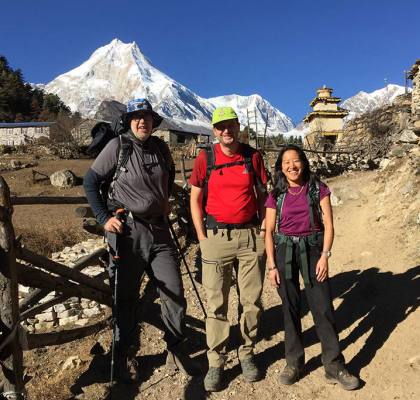
Manaslu Circuit Trek A First Time Trekkers Experience In Nepal ‘Will it be wintertime in Nepal and the Himalayas during December? How many days will you be trekking? Have you been there before?’ asked my work colleagues. ‘Er, yes, 12 days of actual walking, and no,’ I replied, knowing my Noosa workmates would be experiencing daytime temperatures of 25-32oC (77-90oF) while I would be experiencing 0- 15oC (32-59oF). Maybe lower. Definitely lower at night. Pretty cold for someone like me, born in the subtropics of Australia. I was 44 years old. I’d become reasonably fit over the past few years, but I’d never considered myself “sporty or athletic” at school. This would be the second trek of my life. The first trek elsewhere had only been four days long. I emailed Responsible Adventures often while preparing for the trip. Raj always replied promptly and supplied a list of clothes and equipment to bring. An excellent all-season sleeping bag for sub-zero temperatures was essential. “You can hire a sleeping bag in Kathmandu but not trekking poles. You can buy them here. I know from experience that cheap ones can last from a few hours to a whole trek. A good pair is an investment if you trek regularly… Bring a repair kit too.” Raj’s words became golden along the Manaslu Circuit. I remained comfortably warm inside my Kathmandu-hired sleeping bag during sub-zero nights. And because I had a repair kit, I could super-glue one trekking pole together again after over-zealously using it as a thorn-clearing scythe. As I walked with my 8kg daypack from 800 to 5135 meters above sea level and down again, I realized that the walking track exists so that food, goods, and people could move between the villages along the way. We, trekkers, were recent additions. Raj and his team carried my other 12kg of gear, organized trail visas, procured evening accommodation, regularly checked on my travel mates and health, and ensured a supply of safe water and nutritious food. They included super-food ingredients such as goji berries for energy, altitude acclimatization, and anti-inflammatory effects. And every morning, we got a lovely warm ayurvedic tea to start the day. In a relaxed, informative, and sometimes humorous way, the Responsible Adventures team informed us about Kathmandu’s colourful road traffic, how to pass mule trains (these are the “Mack goods-hauling trucks” of the Manaslu circuit walking track) and how to give goats (surprisingly easy, even when there are hundreds). In addition, I learned the names of trees, animals, and mountains, how to estimate altitude by the tree line, and discussed the pros and cons of Nepal’s planned upgrade of some walking track sections to vehicle-class roads. When we encountered the unexpected, like heat waves, landslips, or freezing gale-force winds, Raj and his team always got us through. I could focus on walking and enjoy the adventure while Responsible Adventures took care of the rest. I highly recommend them to anyone looking to do guided treks or tours. They operate in Nepal, Tibet, India, and Bhutan. By Chris Dowding – structural engineer, amateur trekker, and author of ‘A Few Drops Short of a Pint.’ He did the Manaslu Circuit Trek. Check out our Trekking packages for Nepal, Bhutan, India, and Tibet.
First Experience of Trekking In The Himalayas

First Experience of Trekking In The Himalayas My first trekking experience was in the Nepal Himalayas. Annapurna Circuit Trek November/December 2014 A month before my fortieth birthday, I undertook my first trek, having never done anything like it or similar before. My experience with Raj’s company, Responsible Adventures, from the first e-mail I sent inquiring about trekking, could not have been better. The months leading up to Nepal’s departure saw me preparing for something entirely new for me, and Raj’s advice was invaluable. I was in regular contact with Raj asking many questions, which he patiently and comprehensively answered, which was very reassuring. I had booked to spend some extra days in Nepal outside the trekking itinerary, splitting the time between Kathmandu before the trek and Pokhara after it. Raj assisted me with my additional inquiries and travel arrangements and met with me the morning after arriving in Kathmandu. Raj took me on a walking tour of Kathmandu and Swayambhunath, the Monkey Temple. Raj also gave me some other ideas about spending my time in Kathmandu. Knowing that I enjoyed cycling, I suggested I rent a bicycle and cycle to the medieval city of Bhaktapur in the Kathmandu Valley. This was quite an eventful ride and one I certainly could not have planned! Dodging the busy weekend traffic of the city and negotiating my way through the main and side streets was quite an experience and tested my cycling abilities in ways I didn’t think were possible! This said, I had an enjoyable day exploring another part of the Kathmandu Valley rich in some of the most exquisite religious architecture, narrow cobbled streets, various squares and courtyards filled with temples, red brick houses, shrines, statues, and other artefacts. The trekking itinerary soon arrived and consisted of a car journey to Besi Sahar, where my trek would begin. After lunch, we set off for Bhulbule, and I took my first steps of many on a trip that would excite and delight me at every corner and have me fall in love with the Himalayas. Being my first day, I had no idea what to expect, but my guide ensured I was looked after, arranging my order for that evening’s meal along with plenty of hot tea and breakfast the following day. I soon fell into a routine that served me well. It helped me adjust to life on the trekking route, providing me with a sense of self-assurance and confidence in an area that, to begin with, was unfamiliar to me but soon became very regular and comfortable. One I would come to miss once the trek had concluded. A typical day started with my guide knocking on my door in the morning, and after getting ready, I would go to the dining room for breakfast, which was always served promptly. After breakfast, I would pack my final bits, and then we would set off for a day of trekking and chatting! My guide ensured I was kept safe and well on the trek, pointing out any hazards such as thorny bushes and nettles in the lower regions and advising on how to negotiate any terrain that might be tricky. For me! He also carried my trek pack, arranged the evening’s accommodation at every destination at the end of each day, and ensured I was well fed and hydrated. In the lower regions, it was clear to see the industrial progression, including hydroelectric plants, fish farms, and of course, the road slowly creeping further along the trekking route. This took up quite a lot of the conversation, to begin with, with me asking about how this impacted the local communities and their lives and the pros and cons of this modern advancement. As we started to leave this behind, my attention turned more towards the mountains and even more stunning scenery and local life along the route. As we ascended, the landscape began to change, and once we got above 3,000 meters, my guide added an acclimatisation walk to the day’s trek. This usually consisted of an additional hike for about an hour and a half heading upwards before coming back down to the tea house, seeing me trekking high but sleeping low. I am sure that this helped me acclimate to the altitude and meant that I did not need to rest day in Manang. I certainly didn’t feel I needed to have a rest day. Although I noticed that sleep was becoming a little more elusive, the further up we got, I always felt healthy and well, and the altitude did not appear to have any adverse effects on me. Despite this, my guide did suggest I add garlic soup to my already increasing meal in the evening, saying that it would help with acclimatisation. As my appetite didn’t appear to be suffering, I happily added it to my dinner order! Feeling strong and well during the trek meant that we seemed to be making good time on each day’s walk, so when we arrived at Thorung Phedi at lunchtime, we decided to head up to High Camp in the afternoon rather than spend the night lower down. This also means that the long day going over the high pass at Thorung La would be slightly shorter. It was always lovely that I could discuss these sorts of things with my guide, and it made me feel like I could give some strong opinions as to how the day would unfold, and I wasn’t just being led the whole way. It was also nice to know that my idea was considered and valued by my guide. The morning going over the high pass, Thorung La, started early (I had not slept much that night, but it did mean I was able to witness some of the most incredible night skies I would ever see), and we were the first to leave High Camp under a moonlit sky. I was told that night’s temperature had been in the region
Everest base camp trek during the winter season
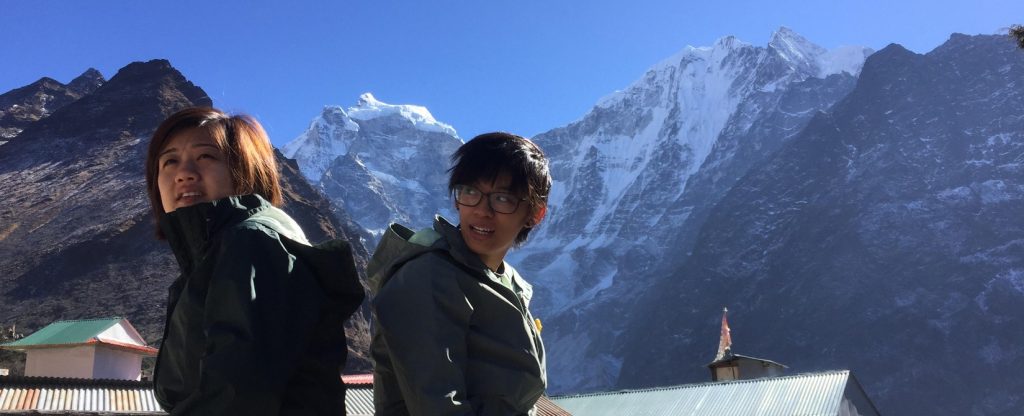
Everest Base Camp trek during the winter Everest Base Camp trek during the Christmas and New Year Holidays. Stephanie contacted us a few months before about Jessica’s trek to Everest base camp. Stephanie and Jessica did the Mardi Himal trek with us in December 2015 with four other friends from Singapore. They confirmed the dates after their vacation got approved at work. They arrived in Kathmandu on the night of the 18th of December. We met for breakfast, and they were helped in the hiring of sleeping bags and doing some shopping for trekking gear on the 19th. We parted ways after they were briefed on their departure from the hotel to the domestic airport to catch Lukla’s flight. Flight to Lukla and trek to Monjo Before heading to the domestic airport, we met at the hotel restaurant for breakfast. Then, we went through the usual formalities of checking in through the security gate, checking in with the airlines with yet another security check, and waiting for the announced flight. Unfortunately, the flight was delayed by just over an hour, usually in Kathmandu, due to the foggy weather in the morning and air traffic congestion. When our flight was finally announced, we boarded the bus, boarded the aircraft, and took off for Lukla. We arrived in Lukla 25 minutes after takeoff, and it was a smooth flight with clear weather. Upon landing at Lukla, we were met by our support crew, who claimed our luggage and met us at the lodge we stayed in at the end of our Everest region treks. Jess and Steph had hot tea while we sorted out the packs for the porter, etcetera. Once the porter’s load was organized, Jessica and Stephanie were given a briefing on how to stay safe while on the trail, especially how to avoid being pushed down the path by pack animals and icy parts of the track. We decided to go to Monjo, two hours further than the usual stopping place at Phakding, for several reasons. We had arrived with plenty of time, and hiking kept us occupied and warm. People from tropical countries at sea level have more difficulties in the cold and altitude, making them slower trekkers than people from Europe, North America, and other countries with four seasons. We stopped for lunch at Phakding at our staff Sundar’s sister’s eatery for Dal Bhat – a Nepali staple consisting of lentil soup, some vegetables, spicy pickles, and chicken or mutton curry. Our team proceeded towards our final destination, Monjo, after lunch. Some trekkers were on their way back, along with mules that had taken supplies to the lodges that were restocking for the coming spring season. We reached Monjo around 4.30 pm. The lodge owners had to be phoned as they had gone to the next village of Jorsalle to plant potatoes. We went to our rooms and sorted our gear before coming down to the woodstove’s warmth in the dining room. After dinner, the ladies were briefed on the next day’s program, and we all retired just after 9 pm. Trek to Namche Bazaar. We were woken up with a hot cup of ayurvedic drinks. This drink contains ingredients that help energize trekkers; it is anti-inflammatory and eliminates cancerous cells. The team started our trek at 9 am, stopping at the Sagarmatha (Nepali name for Everest) national park entrance point to register our trekkers. It is a short 3-hour trek to Namche Bazaar from Monjo, with the final two hours a steep uphill climb. There were some icy bits on the trail where streams flowed. The Singaporeans got their first glimpse of Everest halfway through the trek. Namche was reached in time for lunch. We agreed to meet at 2.45 pm to wander around town before going to our rooms and having hot showers. While walking around Namche Bazaar, we noticed that most shops were shut as the owners had left for ‘warmer’ Kathmandu. We went into the Liquid bar to watch Sherpa, the movie. Unfortunately, the weather had gotten foggy when we came out. We returned to the lodge to have our dinner; as usual, the ladies were briefed on the following day’s program. The plan was to take them to Khumjung village (this is where Sir Edmund Hillary built the first school) for lunch and proceed to Laushasha, similar to Namche. This was again to help the Singaporeans cover some ground to make the next shorter. Namche to Laushasha It was a glorious morning with beautiful blue skies and mountain views. We sorted our things in the rooms upon arrival at our stop for the night and gathered in the dining room to congregate around the wooden stove. We had several rounds of hot drinks and dinner and went to bed early again. Pangboche 3980 m We started our trek after breakfast with a downhill hike for half an hour to Phungkitanga and checked in with the national park rangers before starting our uphill climb to Tengboche Monastery. Once we walked uphill for a few minutes, we took off our layers and hiked in T-shirts. We arrived in Tengboche two hours later for lunch. We walked around the vicinity and took many photos of Mount Tawache, Nuptse, Everest, Lhotse, Kangtega, and Thamserku. We had a leisurely ninety-minute hike after lunch to Pangboche. We started to head to our final destination at around 2 pm and reached Pangboche at 3.30 pm. I took a hot shower (the last one for the next five days as we would be at a higher altitude and colder) before the sun went over the hill while it was still warm. The ladies went to bed at 8.30 pm, and we retired at the usual 9 pm. Amadablam Base Camp 4580 m We headed out for Amadablam base camp for an acclimatization hike after breakfast. Before reaching ADBC, we first had to walk down the Dudh Koshi river, followed by a mixture of steep and flattish terrain. It was
Trekking in Nepal during February
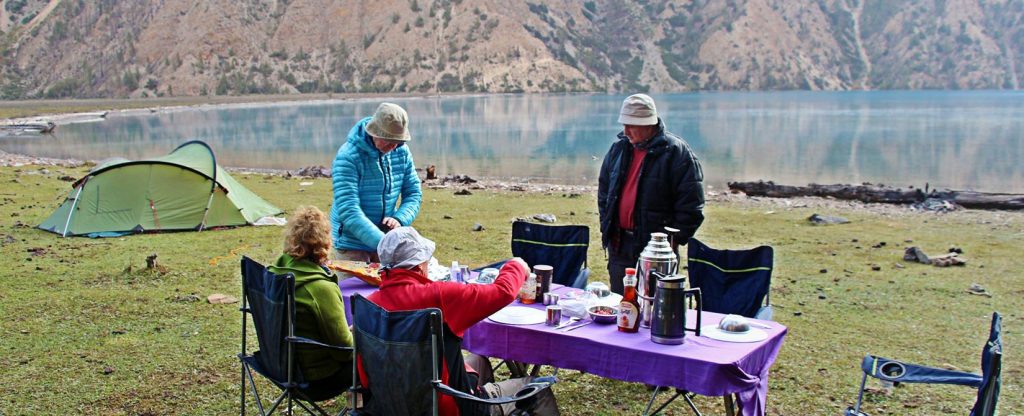
Trekking in Nepal in February February is one of the coldest months in Nepal, even though it is the end of winter. The Arabian Sea or The Hindu Kush’s Westerly disturbance region can bring rain in the low to middle hills and snowfall in the higher altitude areas. Interestingly it snows more in February than in December and January. Most people do not come to trek in Nepal this month, thinking it will be super cold and most of the country will be blanketed in snow. It is better to do treks in the lower elevations such as the Ghorepani trek, Everest Treks to Namche, Tengboche, Pangboche, or Short treks near Pokhara and Kathmandu. If possible, avoid the Annapurna Base camp trek as part of the trail becomes avalanche prone. However, you can prevent the dangers if you start early in the morning while fresh snow is still frozen rather than when the sun begins to melt the snow/ice and gravity causes an avalanche. Also, avoid doing Annapurna Circuit, Tilicho Lake, and Manaslu Circuit treks, as the passes can be covered by snow, and the trail can be icy. Having said this, Europe and North America would be much colder than Nepal during February. It always pays to invest in the right equipment such as a suitable down jacket, sleeping bag, a couple of layers of fleece, the right thermal underwear, thick hiking socks, gloves, trekking pants, warm hats, and perhaps even walking crampons, to name a few essential gears to invest in. It is always better to have more than less. It is good to dress up in layers that you can ‘peel’ one at a time when you start to warm/heat up as you begin trekking. Benefits of Trekking in Nepal Himalaya during February. Most people think winters in Nepal are freezing, and some might even imagine most of the country is covered in snow. This couldn’t be further from the truth. The clouds begin to form in the latter part of the day, and it can start raining at the lower altitude and snowing in the higher elevations during the late afternoon or evening. This is a good thing as it can clear the clouds and clear the clouds for excellent mountain views the following day. The past two winters have been clear like they used to be some 20-25 years ago. There will still be fewer trekkers on the trail and in the lodges if you go trekking during February to the popular trekking areas where there are lodges. You will be warm while hiking in the sunny weather – perhaps even sweat on the uphill climbs. You could be the only trekker in the lodge. For the same reason, the wifi works better in the hostels as fewer people log in. You can use the internet better for weather forecasts and temperatures. There will be fewer people queuing for hot showers. Despite winter, don’t be surprised by the greenery or flowers in the lower altitudes. The closed lodge owners start returning from warmer places such as Kathmandu, Pokhara, or Chitwan for the winter season. Can I do a high-altitude trek in Nepal during winter? You can undoubtedly do a high-altitude trek in Nepal during winter. The better time to do a high-altitude trek during winter is in December and January. We do receive some precipitation for a few days every month. We receive more massive snowfalls during February and March rather than in the middle of winter. Dangers/Inconveniences of trekking in Nepal during winter. Most of the lodges have started opening again. Not all food on the menu will be available. The toilet floors might freeze from water/urine spillage in the higher altitude treks. If possible, try to find toilets inside the main building; better still, ask if they have a room with an attached bathroom. Again, minimize spillage in the bathroom to avoid icing. Toilets could be frozen/blocked due to the cold at higher altitudes. The paths through villages could be icy because the villagers have to let the public tap run all the time to prevent the pipe from breaking from freezing. The trail could be icy, and dirt can camouflage the ice. There could be very windy conditions in the higher elevations, be prepared. You will likely face rain in the lower elevations and snow in the higher mountains during February. You might encounter rain/hail/snow storms due to the Western disturbances from the Arabian Sea or the Hindu Kush range. You must be careful of flying debris such as signboards, zinc roofs, falling branches, or even uprooting trees. Update: February 2022 experienced a decent amount of rain and snow, depending on the altitude. February 2019 has received good rain and snowfall up to the third week; the precipitation has been more than usual. Nepal experienced heavy snow and rainfall during the last four days of February 2019. Kathmandu valley and the surrounding hills experienced snowfall twice a month. On the 26th of February alone, it received 90mm of rain – 5 times the average monthly rainfall. Check out our Trekking packages for Nepal, Bhutan, India, and Tibet.
Trekking in Nepal during January
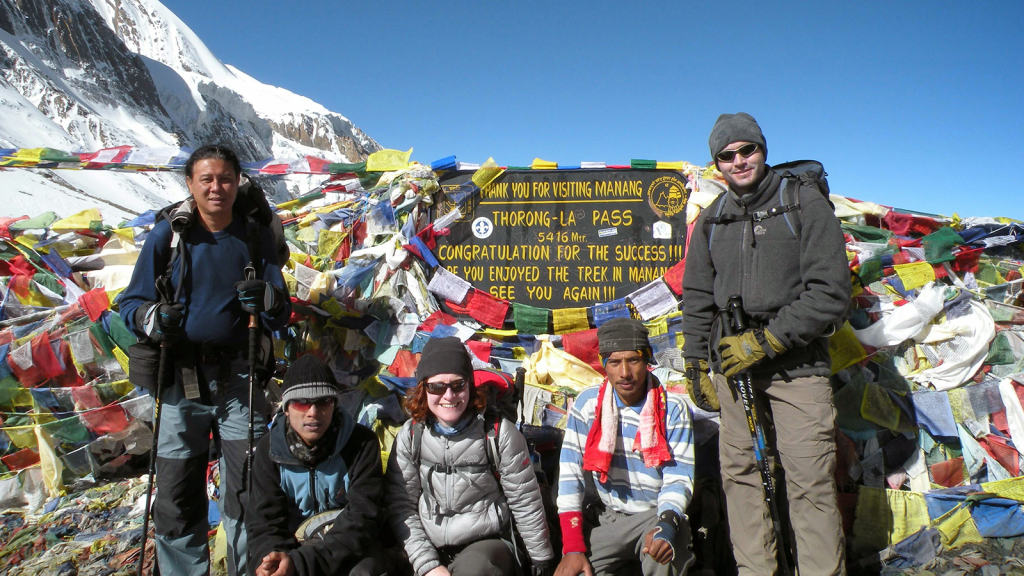
Trekking in Nepal in January January is the middle of winter and the coldest month in Nepal. Most people do not go trekking in Nepal for several reasons, such as fearing the extreme cold and heavy snowfall, which raises safety concerns. Little do they know that January is one of the best months to go trekking not only on Nepal’s lower altitude trek such as the Ghorepani route, Mardi Himal, and Everest Panorama but also on some of the well-trodden paths such as Gokyo Lakes and Everest Base Camp or Everest Base Camp or Annapurna circuit with Tilicho lake. The last decade has seen a decrease in snowfall in January. However, there is precipitation for a few days every month, where it rains in the lower elevations while it snows in the higher mountains. It is good to dress up in layers, which you can ‘peel’ one at a time when you start to warm/heat up as you begin trekking. A friend and I personally did a winter trek of Annapurna Circuit with Tilicho Lake this January with relative ease. Most lodges have Internet connections with WIFI facilities; it is easy to check the weather forecast in advance. The online weather apps claimed temperatures to be -18 in places like Manang, 3500 meters, or even -24 on the Thorong La pass at 5416 meters. We were warm with our sleeping bags and an extra blanket. We were comfortable walking during the day and even perspired on uphill climbs. It is always better to be over-prepared rather than underprepared. What to expect while trekking in January? You can expect the temperatures to be colder, which ensures the clouds stay low, making the view of the mountains visible for most of the day, if not all day, for several days. The trekking trails and the lodges will be less crowded, which makes it pleasant. There will be no queue for hot showers; your meals will be served faster. You might even have the lodge to yourself. Try to have additional days if you intend to do high-altitude treks; the mountains’ weather can change with little warning. Sometimes snowfall can cut off high passes for a few days. Beware of icy conditions on the trail when trekking in winter. Be extra careful when you pass villages higher than 2500 meters. The villagers leave the communal taps running to prevent them from freezing and pipes breaking. This can make the area near the faucet very icy and sleek. Will the lodges and restaurants on the trekking trails be open? Most lodges and restaurants in the lower elevations will remain open. However, some hostels are closed in the higher altitude villages as the owners go to warmer places like Kathmandu, Pokhara, or Chitwan. Some of the lodges are left to the employees to run during the winter off-season. You don’t have to worry; some clubs are open in the higher villages; otherwise, the person running the hostel will inform you if the lodges on your way are all closed. What equipment to bring for Nepal trekking in January? You are advised to dress up in layers during winter trekking in Nepal. It can be sunny during the daytime making it easier to take coats off as you begin to warm up. Good trekking boots are advised in preparation for possible snow and ice, along with thick socks. Thermal underwear, and Merino wool products, are a good investment if you plan to hike in high-altitude areas. They are supposed to stay odourless for up to two weeks; these will help if you feel the cold and can’t take showers for extended periods. An excellent windproof jacket and a thick winter trekking or down jacket will be helpful. Bring a suitable sleeping bag; if you feel cold, blankets are more readily available than during the peak season for additional warmth – do be warned, and some quilts can be smelly. You are expected to eat at the lodge you plan to spend the night. However, they have a higher charge if you eat outside as their profit comes from your meals rather than the room charge. Do I still need Trekking permits? Yes, you will need trekking permits throughout the year. It is available in Kathmandu and Pokhara. You are also advised to have proper travel insurance covering helicopter evacuation in case of illness, accident, natural calamity, or political uprising. Update: January 2021 – It rained in altitudes lower than 3000 meters, and higher altitude areas experienced snowfall during the first week of the new year. It was caused by the Western disturbances bringing a cold front for a couple of days in Nepal. January 2020: Nepal, Sikkim, Darjeeling, and Bhutan experience early snowfall on the 3rd to 5 of the month. We experienced more precipitation on the 8th, 9th, 16th, and 17th of January. This year we experienced snowfall that was three times more than usual. January 2019: It snowed in Eastern Himalayas on the 1st and 3rd of January. January 2019 experienced a good amount of rainfall and snowfall like it used to two decades ago. Check out our Trekking packages for Nepal, Bhutan, India, and Tibet.
Trekking in Nepal in December
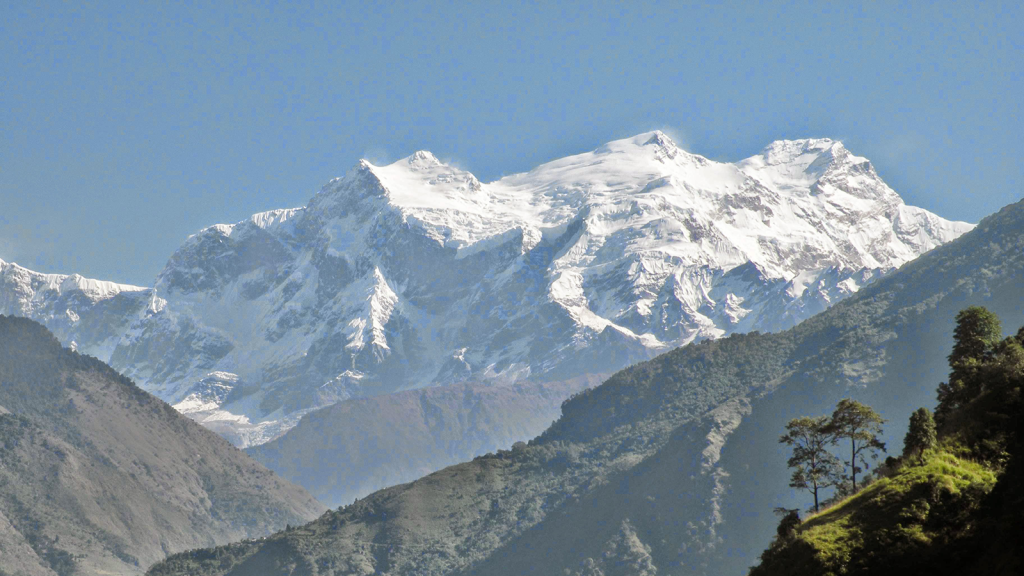
Trekking in Nepal during December Most people are discouraged from trekking in the Himalayas, the highest mountain chain in the world, during the winter. They think trekking in December is crazy, suspecting it to be super cold and snow blankets the whole nation blanketed by snow. They could not be more wrong. Nepal is of similar latitude as Cairo and Miami, closer to the Equator than the Arctic Circle. So if you go trekking in the middle hills with altitudes ranging between 1000 meters to 3500 meters, don’t be surprised if the temperatures are in the high teens or even low 20s degrees Celsius than the summer of most Northern European nations. However, it always pays to invest in the right quality gear, such as a down jacket, a couple of fleece jackets, pants, base layers, warm hats, gloves, and sleeping bags, to name a few essential types of equipment. It is better to have more than less. One of the best-kept secrets is that trekking in Nepal during the winter has many benefits. The days when it snows by the second half of November or early December are long gone. However, a few days in December, precipitation can result in rain in the low to middle altitudes and snowfall in higher elevations. It is good to dress up in layers, which you can ‘peel’ one at a time when you start to warm/heat up as you begin trekking. Benefits of Trekking in Nepal Himalaya during December. For the same reason mentioned above, most people think winters in Nepal are freezing, and some might even imagine most of the country is blanketed in snow. This couldn’t be further from the truth. The colder weather keeps the clouds down longer, and even if the clouds form and rise in the afternoons, they sink quicker due to the cold than in the warmer months. This makes the visibility of the mountains clear for most of the day. You will have the feeling of having the whole place to yourself. The views over the past two winters have been unobstructed like they used to be some 20-25 years ago. There will be many fewer trekkers on the trail and lodges if you go trekking to the famous trekking areas where there are lodges. You will be warm while hiking in the sunny weather – perhaps even sweating on uphill climbs. You could be the only trekkers in the lodge. For the same reason, the wifi works better in the hostels as fewer people log in. You can use the internet better for weather forecasts and temperatures. There will be fewer people queuing for hot showers. Despite winter, don’t be surprised by the greenery or flowers in the lower altitudes. The open lodges in the higher altitudes are left to the employees during winter, while the owners go for warmer places such as Kathmandu, Pokhara, or Chitwan. The employees keep the profit from food sales and only have to replace what they used. Therefore, this is a way for the employees to supplement their low salaries. Can I do a high-altitude trek in Nepal in December? A high-altitude trek in Nepal is possible during December. The better time to do a high-altitude tour during winter is in December and January. We do receive some precipitation for a few days every month. We have begun to receive more massive snowfalls during February and March than in the middle of winter. Dangers/Inconveniences of trekking in Nepal during winter. Not all the lodges in the higher altitude will be open; no need to worry, as you will find a place to spend the night quite comfortably. Not all food on the menu will be available, but there will be enough to fill you up. The toilet floors might be frozen from water/urine spillage in the higher altitude treks. If possible, try to find toilets inside the main building; better still, ask if they have a room with an attached bathroom. Again, minimize spillage in the bathroom to avoid an icy floor. Toilets could be frozen/blocked due to the cold at higher altitudes. Water supply via pipe will be disconnected in higher elevations as frozen water expands and breaks the pipes. The paths through villages will be icy because the villagers have to let the public tap run all the time to prevent the pipe from breaking from freezing. The trail could be icy, and dirt can camouflage the ice. There could be very windy conditions in the higher elevations, be prepared to bring proper windcheaters and warm layers. Despite having mentioned this, there is less snowfall in December and January; you might still encounter rainfall in the lower elevation or snow – after all, mountain weather can change without much warning. We have operated these treks in the winter months of December and January. 2014 Annapurna Circuit Trek We did a trek to Annapurna base camp in December/January 2014-2015 2016 Manaslu circuit in December. We operated a trek to Langtang – Gosainkunda in December/January 2016-2017 2017 Gokyo Lakes and Everest Base camp in December 2017. 2018, 2019 We did the Everest base camp trek with Singaporeans in December. We did Family Annapurna Trek during December at the lower altitude. When we did the Annapurna circuit trek with Tilicho Lake in January 2018, we met tourists and locals who misinformed some trekkers. Locals told them that the higher villages and the Thorung La 5416m pass were covered in deep snow. The people who said these will likely have done very little or no trekking experience. December 2021 – There was some rain in the lower elevations and snowfall above 2300 meters at the end of this month. Some areas received as much as 50 mm of rain and snow between the 29th and the 30th of December. December 2020 – The weather remained fair, and temperatures were much warmer than in the previous two years. In addition, we witnessed an average of 3-5 days of precipitation.
Trekking to Gokyo Lakes and Everest base camp in early winter
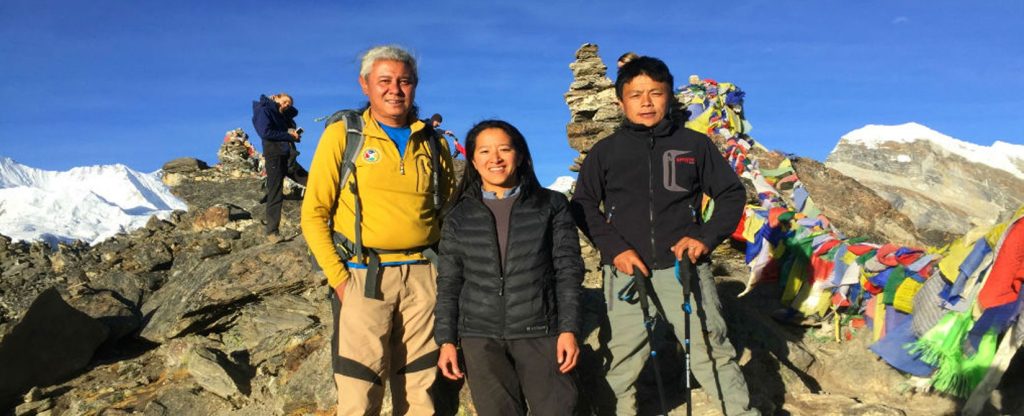
Gokyo Lakes And Everest Base Camp Trek In Early Winter Gokyo Lakes and Everest Base camp trek in early winter. 1st December – 20th December 2017 Chris and Tara did the Manaslu Circuit trek with us in December 2016 and had spoken about doing the Three high passes of Everest and a possible tour of Tibet the following year during the walk. The planning of the trek. Chris initiated the communication on the Everest trek’s three high passes and a tour of Tibet two months after getting home. We exchanged numerous ideas and itineraries via email over several months. Ten weeks before the trek began, Chris faced a hiccup at work, one of his engineers resigned, and the project they were working on needed to be finished before the end of the year. Then, two weeks before the trek, Chris confirmed his worst fears – he couldn’t complete the project before the hike and had to pull out at the last moment. This left Tara to do the trek for which all her holiday time and flights had been finalised. My team’s other worry was the early onset of cold weather from mid-October onwards – this would make the conditions on the high passes icy and potentially dangerous. However, we firmly believe in prevention rather than cure – I advised Tara on the potential risks of doing the high passes during December while also of the possibilities of meeting people who had done it while on the lodges and trail. Tara kindly agreed to follow our advice and stay on the safe side rather than risk injury and an early end to her holiday. So we decided to do the Gokyo Lakes and Everest base camp trek for safety measures. Tara was met at the airport by me, brought to her hotel, and later that evening, we had dinner with our team of climbers who had just returned the day before from Lukla. This was Tara’s third trek with our company. The next day Tara had a free day to wander around and do things in Thamel while I had some chores to be handled. We agreed to meet the following day in the hotel lobby before going to the airport for our flight to Lukla. Tara at Gokyo Ri 5364m Lukla and Beyond. At our agreed time, I met Tara and drove to the domestic terminal to catch our flight to Lukla. Everything seemed to be on schedule; our flight was announced, and we boarded the bus to take us to the aircraft. A few minutes later, the airline crew announced the delay in departure as the fog rolled on the runway, making visibility poor for planes to take off. Seventy minutes of uncertainty, then there was a flurry of activities at the airport grounds, and soon we were driven to our aircraft, boarded the plane, and were airborne after 15 minutes. We reached Lukla airport in 25 minutes, and as usual, there were many activities with aircraft landing and a rapid turnaround to return to Kathmandu. Our support crew consisting of Sundar and Dil met us at Lukla. We walked to our lodge to have some hot drinks. We decided to go further than our planned stop at Phakding; instead, we opted to go on for two more hours to Monjo’s village. We stopped for lunch at Phakding and continued to Monjo. We got to our destination 5 hours after leaving Lukla. The temperatures had plummeted in just a short three days since I had gone to Lukla. The daughter-in-law had taken over the Monjo Guesthouse. She happened to be a former colleague of Sundar, and they had a great time catching up and speaking of their time working together. Namche Bazaar 3441m It was a blessing in disguise that we got to Monjo as this was a Saturday, and Namche had its weekly market. We would make it in time to witness this decades-old traditional market towards the end. We had a twenty-minute hike to the Sagarmatha National Park entrance, where registration takes place. Then, we proceeded towards Namche crossing the new high bridge (seven suspension bridges from Lukla to Namche). There is a steep ascent to Namche from the last bridge, which happens to be the highest. We arrived in Namche in time to see the remaining traders with their goods and wares. It had been more than a couple of decades since I had witnessed this traditional market. It brought back some memories. We stepped into a local eatery to have some dumplings for lunch before checking into our rooms at our lodge. The temperatures had plummeted – two degrees Celsius in the sun. We had an early dinner, discussed the next day’s program, and went to bed early. Acclimatisation day at Namche We went to Sagarmatha National Headquarters at the top of Namche for panoramic views of the surrounding peaks, including Mount Everest. We spent time there admiring the breathtaking views and taking photographs as usual. We visited the natural history museum and walked over to the privately-owned Sherpa museum, Sherpa culture photo gallery, and Everest documentation centre before returning to our lodge for lunch. We decided to watch a free documentary at the Liquid bar. They show free documentaries twice daily at 3 pm and 7.30 pm daily; the documentaries are usually related to Everest. The owner decided to put on Sherpa, the film on the avalanche that killed 16 Sherpas in 2014. It focuses on Phurba Tashi, the second person to climb Everest 21 times after Apa Sherpa. Phurba is also featured on Discovery Channel’s documentary – Everest, Beyond the limit. It was still an engaging experience despite watching it for the second time. We went back to the lodge for dinner and retired in preparation for the next day. Thame village 3800m. We started with a short climb after leaving our lodge to the West of Namche. It was another clear morning with stunning views. Thame’s walk is on a
Winter Annapurna trek with family
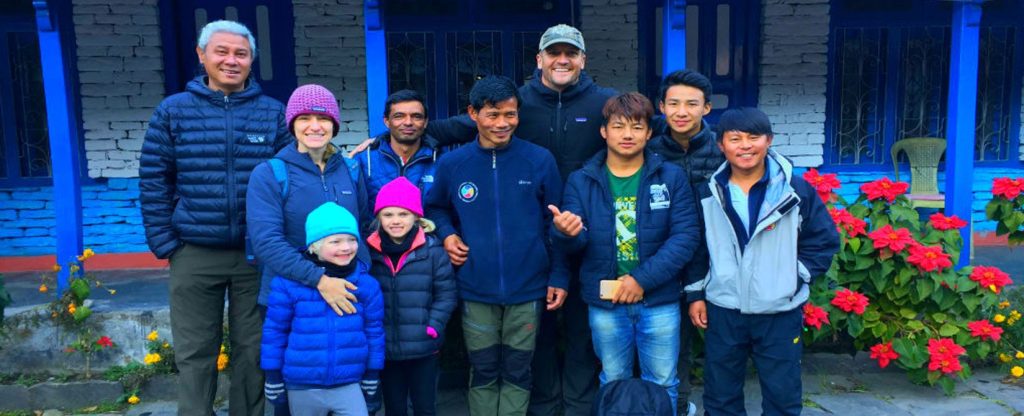
Benefits of trekking as a family Introducing nature to children. We are teaching children a healthy lifestyle. Bonding as a family unit. Learn about different cultures. Learn that their limits can be expanded/stretched. Become more adventurous in trying out new things. Learn how privileged they are. Family Annapurna Trek during winter Andrew had done a helicopter tour of Everest Base camp with his CEO and another colleague in April 2013. He had promised to return with his family, which he did at the End of December 2017. So we tailor-made the family adventure program for the Stanleys. The Stanley family consisted of Andrew, His wife Shea, his 8-year-old daughter Tatum, and his 6-year-old son, Jase. As usual, several emails and WhatsApp messages were exchanged, discussing their needs and support for the Trek. The idea was to make it comfortable enough for the children to do the Trek easily and safely. I organized two porters with modified traditional baskets to carry the kids whenever they got tired during the Trek. We decided on a 6-day trek to Ghorepani, with Poonhill being the highest point at 3210 meters. Pokhara and the beginning of the Trek. The Stanleys arrived from Hong Kong at 10.30 pm on the 27th of December 2017. They had arranged for a vehicle to bring them to the Yak and Yeti Hotel. We had arranged to meet the following day at 6.30 am for breakfast and leave for the airport at 7.15 am for our flight to Pokhara. The flight took off on time at 8.25 am. The views of the Himalayan peaks were visible and stunning during the flight. We were greeted by magnificent views of the Annapurna range at Pokhara airport. We drove to a hotel to store their excess luggage, which wasn’t required for the Trek. We had a few things to be done in Pokhara before going to our starting point at Nayapul. The drive to Nayapul took 90 minutes, and the rest of our support team was waiting for us. There were six of us to look after a family of 4. We hiked a short twenty minutes before stopping for lunch at Birethanti, as we had begun a bit late. We started trekking at 2 pm towards Tirkhedhunga, our stop for the first night. The hike is pretty, walking alongside the clear and beautiful Burungdi River with several impressive waterfalls and whitewashed houses on the trail. Sadly like most parts of Nepal’s trekking trails, there is a fair-weather road, and passing jeeps can make the Trek a bit dusty. However, this is a minor annoyance compared to the beauty of the scenery. The family did well during the first day’s hike. Jase was a bit reluctant to sit in the basket to be carried, but he enjoyed the ride once he was convinced to do so. We finished the Trek in a shorter than usual time, which was two and a half hours. Upon arrival, we had hot drinks before going to our rooms to sort things for the night before dinner. The Stanleys went to bed early, tired from the previous night’s late arrival and the first morning’s early start. We parted after deciding on being woken up at 7 am. Day 2. Banthanti 2300 meters. Our staff woke the parents up with our exclusive ayurvedic drink. I was later informed that the adults loved the concoction they were given in the morning (they asked for the recipe and continued to drink this in the morning back home). We started the Trek after breakfast. It was a steep climb on steps that usually took two hours with a gain of 500 meters. Jase was carried for most of the hike while Tatum did most of the walking despite the steep ascent. It took us only one hour and thirty-five minutes to reach Ulleri, where we stopped to have a hot drink and enjoy the view of Annapurna South. The hike is less steep from Ulleri to Banthanti, and it took less than an hour to reach our destination for the day. We arrived in time for lunch. Our lodge was busy serving food to a large group of Nepali student trekkers. We had a relaxing and free afternoon. The children were kept busy with their colouring books until dinnertime. Our team prepared Thai green curry and stir-fried vegetables with oyster sauce for the parents while allowing the children to choose what they felt like eating. The adults complimented us for the tasty dinner. They retired early, as the second day of hiking wasn’t usual for the children. Day 3 Ghorepani 2850 meters. This day’s hike is in thick Rhododendron forests with stunning waterfalls and a Pretty River. Tatum walked the whole way to Ghorepani without being carried. We arrived in Ghorepani in time for lunch. I discussed with Shea and Andrew about going to Poonhill in the late afternoon for sunset rather than sunrise the following day to avoid the crowds, to which they agreed. We left for Poonhill at 4 pm and arrived there after 45 minutes. The weather was clear mostly except on Mount Dhaulagiri, 8167 meters, where clouds blocked part of the peak. We were rewarded with a beautiful sunset, and the family was happy with the decision. We returned to Ghorepani in time for dinner and had another early night. Day 4 Tadapani 2650 meters. The previous hike to Poonhill was also decided because it would cut this day short by ninety minutes. We woke up to clear views of the Dhaulagiri and Annapurna ranges. The hike began with an uphill climb for an hour, and the peaks greeted us with gorgeous views. Many trekkers on the trail pleased us even more with our decision to go to Poonhill the previous evening. The path becomes undulating after the first hour of the climb before descending steeply for another hour till we reach Banthanti for lunch. This is a different Banthanti from day 2. This place is usually


